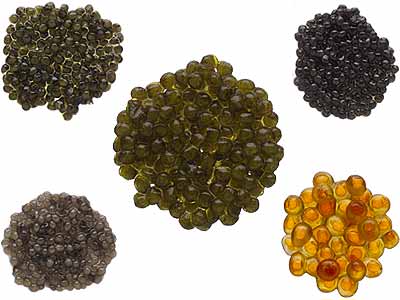
There’s nothing more luxurious than serving caviar as a holiday appetizer. But don’t go dropping $1,000 on fish eggs without learning about the market.
Caviar is the roe of the sturgeon, the thin, oily, rich-tasting, white-fleshed, prehistoric-looking fish from the Caspian and Black Seas. Sturgeon eggs are harvested, then salt-cured, and, voilà, a pricey delicacy is born. The main varieties of sturgeon are Beluga, Persicus, Osetra (or Asetra), and Sevruga. In September, Beluga caviar, once the most desired and expensive variety, was banned in the United States because of the fish’s endangered status (it can be bought in other countries, but it’s illegal to import). If caviar is from a fish other than a sturgeon, it’s noted in its name, such as American Spoonbill caviar or salmon caviar. These products are generally considered less desirable than sturgeon caviar. Nowadays, much sturgeon caviar is farm-raised; because it’s raised in fresh water, farm-raised caviar isn’t as salty as wild caviar and its flavor isn’t as nutty and complex (it’s also less expensive).
Caviar varies in flavor, texture, and appearance depending on the type of sturgeon from which it comes and the area from which it’s harvested. Rod Mitchell, owner of Browne Trading Co., a caviar supplier to seafood restaurants and retail outlets such as Daniel and Dean & DeLuca, prefers Iranian Gold above all others. “It has all the desirable qualities you’d want in a caviar—it’s light golden in color, has a firm texture, and is deliciously nutty and creamy. That’s why it’s so expensive,” he says. The Royal Osetra, which comes from a wild Russian sturgeon and is harvested in Azerbaijan, is next on Mitchell’s list. “It’s almost like the Iranian Gold, but a bit nuttier and fruity,” he says. It sells for about $100 per ounce. Next is the Caspian Sevruga (about $80 per ounce), a small and briny caviar with a pronounced seawater flavor. “The Sevruga’s used in many sauces,” says Mitchell. “Its taste is distinct and strong.” The Black Pearl caviar ($55 per ounce) is farm-raised in Italy and has a consistent black color, an earthy, “trufflelike” flavor, and a delicate texture. If you want to serve caviar but don’t want to pay top dollar, consider American Spoonbill, a relative bargain at $20 per ounce. It comes from the Spoonbill paddlefish, a distant cousin of the sturgeon that’s found in Tennessee and Mississippi. Like Sevruga, Spoonbill has small, silvery pearls and a creamy texture. “You can almost pass it off as Sevruga,” says Mitchell.
Caviar shouldn’t have a fishy smell or taste too salty, says Mitchell. There should be a pop to the eggs (they shouldn’t be mushy), and there should be distinct separation between them. Caviar should also be shiny, and there shouldn’t be evident oil. “It should glisten,” says Mitchell.
Where to Buy
The most important tip when buying fresh caviar is to purchase it from a reputable dealer. A high-quality retail outlet should let you taste the caviar before you buy it. Zabar’s, Balducci’s, Dean & DeLuca, Russ & Daughters, and Petrossian are considered good choices.
More Holiday Shopping Tips:
The Fanatic’s Grocery List: How To Tell A Turkey from A Turkey
And See Also:
The Feasts: Holiday Banquets to the Nth Degree